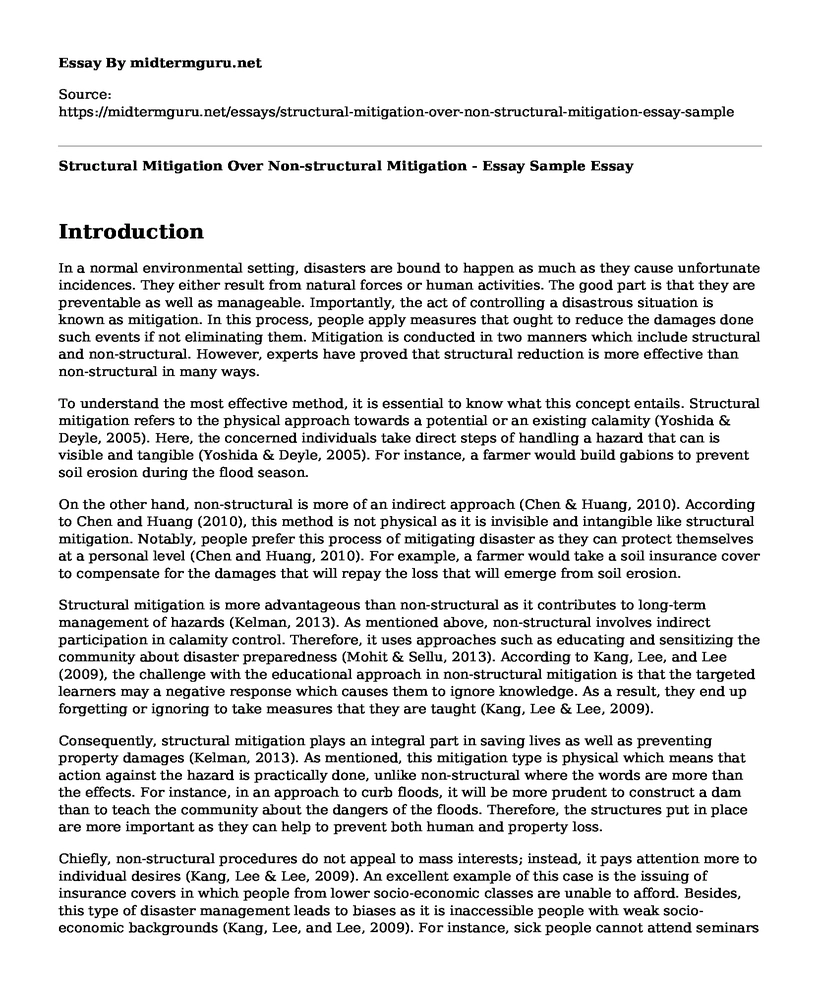Introduction
In a normal environmental setting, disasters are bound to happen as much as they cause unfortunate incidences. They either result from natural forces or human activities. The good part is that they are preventable as well as manageable. Importantly, the act of controlling a disastrous situation is known as mitigation. In this process, people apply measures that ought to reduce the damages done such events if not eliminating them. Mitigation is conducted in two manners which include structural and non-structural. However, experts have proved that structural reduction is more effective than non-structural in many ways.
To understand the most effective method, it is essential to know what this concept entails. Structural mitigation refers to the physical approach towards a potential or an existing calamity (Yoshida & Deyle, 2005). Here, the concerned individuals take direct steps of handling a hazard that can is visible and tangible (Yoshida & Deyle, 2005). For instance, a farmer would build gabions to prevent soil erosion during the flood season.
On the other hand, non-structural is more of an indirect approach (Chen & Huang, 2010). According to Chen and Huang (2010), this method is not physical as it is invisible and intangible like structural mitigation. Notably, people prefer this process of mitigating disaster as they can protect themselves at a personal level (Chen and Huang, 2010). For example, a farmer would take a soil insurance cover to compensate for the damages that will repay the loss that will emerge from soil erosion.
Structural mitigation is more advantageous than non-structural as it contributes to long-term management of hazards (Kelman, 2013). As mentioned above, non-structural involves indirect participation in calamity control. Therefore, it uses approaches such as educating and sensitizing the community about disaster preparedness (Mohit & Sellu, 2013). According to Kang, Lee, and Lee (2009), the challenge with the educational approach in non-structural mitigation is that the targeted learners may a negative response which causes them to ignore knowledge. As a result, they end up forgetting or ignoring to take measures that they are taught (Kang, Lee & Lee, 2009).
Consequently, structural mitigation plays an integral part in saving lives as well as preventing property damages (Kelman, 2013). As mentioned, this mitigation type is physical which means that action against the hazard is practically done, unlike non-structural where the words are more than the effects. For instance, in an approach to curb floods, it will be more prudent to construct a dam than to teach the community about the dangers of the floods. Therefore, the structures put in place are more important as they can help to prevent both human and property loss.
Chiefly, non-structural procedures do not appeal to mass interests; instead, it pays attention more to individual desires (Kang, Lee & Lee, 2009). An excellent example of this case is the issuing of insurance covers in which people from lower socio-economic classes are unable to afford. Besides, this type of disaster management leads to biases as it is inaccessible people with weak socio-economic backgrounds (Kang, Lee, and Lee, 2009). For instance, sick people cannot attend seminars regarding disaster management. As a result, the left-out group ends up suffering destructions; thus contributing to huge losses.
It is important to note a successful mitigation process combines both the structural and non-structural. However, placed on independent grounds, non-structural is the best as it involves direct actions against the disasters. Moreover, it bears excellent outcomes regarding damage control and saving lives during an emergency.
References
Chen, S. C., & Huang, B. T. (2010). Non-structural mitigation programs for sediment-related disasters after the Chichi Earthquake in Taiwan. Journal of Mountain Science, 7(3), 291-300.
Yoshida, K., & Deyle, R. E. (2005). Determinants of small business hazard mitigation. Natural Hazards Review, 6(1), 1-12.
Cite this page
Structural Mitigation Over Non-structural Mitigation - Essay Sample. (2022, Dec 21). Retrieved from https://midtermguru.com/essays/structural-mitigation-over-non-structural-mitigation-essay-sample
If you are the original author of this essay and no longer wish to have it published on the midtermguru.com website, please click below to request its removal:
- Discussion Questions on Environmental Governance - Paper Example
- Ecology Essay Proposal: For Preventing a Long Term Perpetuation and Escalation of Global Warming
- Paper Example on Animal Mistreatment
- Paper Example on Sea Erosion
- Fake News on Effects of Global Warming - Research Paper
- Paris Climate Deal: Uniting Nations to Combat Climate Change - Essay Sample
- Global Warming: Becoming Mindful of Environmental Issues & Solutions - Essay Sample







